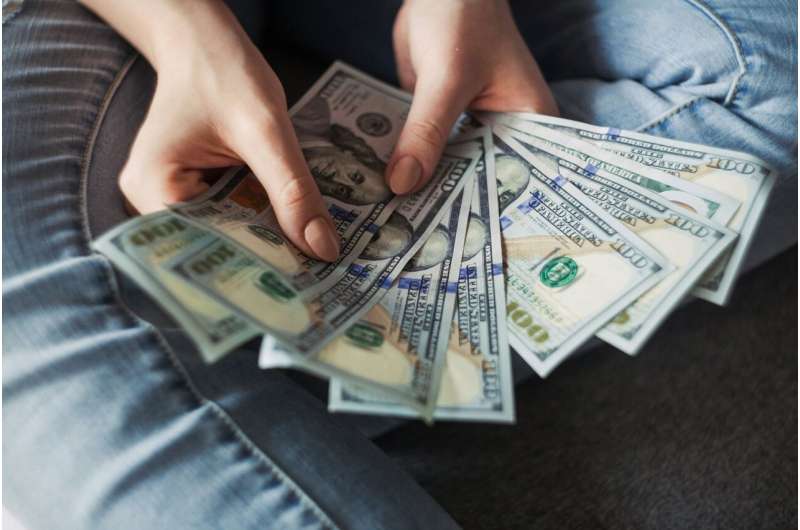This article has been reviewed according to Science X's editorial process and policies. Editors have highlighted the following attributes while ensuring the content's credibility:
fact-checked
trusted source
written by researcher(s)
proofread
Paying people to exercise can be motivating, but the financial rewards don't have to last forever to work

If physical activity came in a bottle, it would be the most prescribed medicine of all. Just walking 10 more minutes a day may yield clinically significant outcomes such as improved mental health, less pain and better sleep. It can also help prevent and manage more than 100 chronic diseases like cancer, arthritis and diabetes.
And yet, many people do not reap the benefits of just a little more movement—about 10 more walking minutes per day, or an extra 1,000 steps.
There are many digital solutions to help people meet physical activity goals, like fitness apps such as MyFitnessPal and Noom. Unfortunately, the challenges of forming healthy habits remain, and use of fitness apps can fall into a familiar pattern reflecting the difficulty of meeting new fitness goals.
With apps, it might look something like this: the app is downloaded with the best of intentions and is used for a couple of weeks. Gradually, the app becomes neglected and begins to collect dust on a smartphone screen, and eventually is abandoned or deleted.
Encouraging activity
As a physical activity expert, I have made it my life's work to encourage more people to be more active more often. A hunch eventually led me to explore the idea of actually paying people to exercise as part of my Ph.D. research. That began in 2010 with a small group of cardiac patients.
Fast forward almost 15 years, and it turns out this idea—paying people to exercise—has legs.
Governments and companies all over the world, for instance, have been paying people to exercise for years. And it works! Sort of. In the short-term, at least.
Predictably, when delivered on a population scale, paying people to exercise can get quite expensive, which is a critical limitation. I experienced this limitation firsthand while developing the Carrot Rewards app in partnership with Canadian federal and provincial governments from 2016 to 2019.
In 2019, due to some fiscal constraints, the financial rewards for exercise offered to Canadians for over a year via Carrot Rewards were mostly withdrawn in Ontario (Canada's largest province) but not in British Columbia and Newfoundland and Labrador (the other two Canadian provinces where the app was available).
This natural variation in financial reward exposure set up an interesting behavior experiment, which provided the opportunity to answer the question: Can financial rewards be mostly scaled back without negatively impacting physical activity?
Phasing out financial rewards
In our large study of 584,760 Carrot Rewards app users, my colleagues and I found that physical activity improvements (about 1,000 steps per day, or 10 more walking minutes) largely remained in Ontario after financial rewards faded away. This was a notable finding, especially since many years of psychology research suggested the opposite; that people revert to baseline behaviors, their "old ways," once financial rewards fade.
One reason for this might be that rewards for daily physical activity achievements were provided for over a year before withdrawal began, which is likely enough time for habit formation.
It may also be because the Carrot Rewards app rewarded the achievement of realistic and adaptive physical activity goals—which increase confidence—with micro-rewards worth only about US$0.05 per day.
Others have found that rewards as small as US$0.09 per day have boosted physical activity in more controlled clinical trial settings.
Applying rewards
What does this mean for those who have fitness apps collecting dust on their home screens?
In a nutshell, this new research suggests people can potentially take a short dose of financial reward to increase physical activity, and once that activity is established (it usually takes about six to 12 months), it may be maintained longer-term with much less expensive financial reinforcement.
So practically speaking, if someone is interested in this approach, it would make sense to seek out financial rewards for exercise—as an impetus, a nudge, a spark.
Some governments have financial rewards-based mobile health programs, such as England and Australia. Employers may offer financial rewards as part of their extended health benefits, which is common in the United States
If neither of those options are available, there are commercially-available financial rewards-based fitness apps like Sweatcoin or WayBetter. With Sweatcoin, goal achievements earn coins that can be redeemed for commercial products in Sweatcoin's online store. With WayBetter, you deposit some of your own money and earn it back plus some if you achieve your goals.
While financial rewards may not work for everyone, our research and that of others is increasingly suggesting they may be one way of stimulating and sustaining a more active lifestyle.
This article is republished from The Conversation under a Creative Commons license. Read the original article.![]()



















